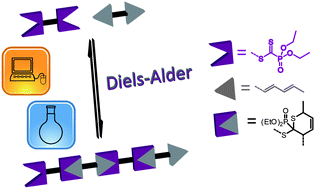Thermally reversible Diels–Alder-based polymerization: an experimental and theoretical assessment†
Abstract
A pair of monomers capable of undergoing reversible

* Corresponding authors
a
Preparative Macromolecular Chemistry, Institut für Technische Chemie und Polymerchemie, Karlsruhe Institute of Technology (KIT), Engesser Strasse 18, Karlsruhe, Germany
E-mail:
christopher.barner-kowollik@kit.edu
Fax: +49 721 608-45740
b
ARC Centre of Excellence for Free-Radical Chemistry and Biotechnology, Research School of Chemistry, Australian National University, Canberra, Australia
E-mail:
mcoote@rsc.anu.edu.au
Fax: +61 2 6125 0750
c Evonik Industries AG, Rodenbacher Chaussee 4, Hanau-Wolfgang, Germany
d Evonik Industries AG, Paul-Baumann-Strasse 1, Marl, Germany
A pair of monomers capable of undergoing reversible

 Please wait while we load your content...
Something went wrong. Try again?
Please wait while we load your content...
Something went wrong. Try again?
J. Zhou, N. K. Guimard, A. J. Inglis, M. Namazian, C. Y. Lin, M. L. Coote, E. Spyrou, S. Hilf, F. G. Schmidt and C. Barner-Kowollik, Polym. Chem., 2012, 3, 628 DOI: 10.1039/C1PY00356A
To request permission to reproduce material from this article, please go to the Copyright Clearance Center request page.
If you are an author contributing to an RSC publication, you do not need to request permission provided correct acknowledgement is given.
If you are the author of this article, you do not need to request permission to reproduce figures and diagrams provided correct acknowledgement is given. If you want to reproduce the whole article in a third-party publication (excluding your thesis/dissertation for which permission is not required) please go to the Copyright Clearance Center request page.
Read more about how to correctly acknowledge RSC content.
 Fetching data from CrossRef.
Fetching data from CrossRef.
This may take some time to load.
Loading related content
